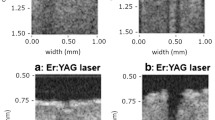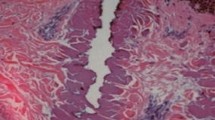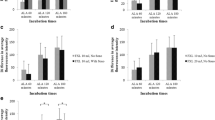Abstract
Ablative fractional laser (AFXL) is an emerging method that enhances topical drug delivery. Penetrating the skin in microscopic, vertical channels, termed microscopic treatment zones (MTZs), the fractional technique circumvents the skin barrier and allows increased uptake of topically applied drugs. This study aims to elucidate the impact of vehicle type on the filling of MTZs from application of liquid, gel, and cream vehicles. Ex vivo pig skin was exposed to 10,600 nm fractional CO2 laser at 5% density, 120 μm beam diameter, and fluences of 40 and 80 mJ/microbeam (mJ/mb). Six repetitions were performed for each of six interventions (2 fluences and 3 vehicle types, n = 36). MTZ dimensions and filling by vehicle type were evaluated by optical coherence tomography, using blue tissue dye as a contrast-enhancing agent. Outcome measure was degree of MTZ filling assessed as percentages of empty, partially filled, and completely filled MTZs (108–127 MTZs/intervention analyzed) and evaluated statistically using Kruskal-Wallis and Dunn’s tests. MTZs reached mid-dermal levels of 225 μm (40 mJ/mb) and 375 μm (80 mJ/mb) penetration depths (p < 0.0001). Filling of MTZs depended on type of applied vehicle. At 80 mJ/mb, liquid (67% completely filled, p < 0.01) and gel (60%, p < 0.05) formulations filled MTZs significantly better than cream formulation (31%). At 40 mJ/mb, liquid and gel formulations filled 90% (p < 0.05) and 77% (p > 0.05) of MTZs completely versus 55% for cream formulation. Thus, filling was overall greater for more superficial MTZs. In conclusion, vehicle type affects filling of MTZs, which may be of importance for AFXL-assisted drug delivery.



Similar content being viewed by others
References
Haedersdal M, Erlendsson AM, Paasch U, Anderson RR (2016) Translational medicine in the field of ablative fractional laser assisted drug delivery: a critical review from basics to current clinical status. J Am Acad Dermatol 74:981–1004
Hantash BM, Bedi VP, Chan KF, Zachary CB (2007) Ex vivo histological characterization of a novel ablative fractional resurfacing device. Lasers Surg Med 39:87–95
Skovbølling Haak C, Illes M, Paasch U, Hædersdal M (2011) Histological evaluation of vertical laser channels from ablative fractional resurfacing: an ex vivo pig skin model. Lasers Med Sci 26:465–471
Hsiao CY, Sung HC, Hu S, Huang YL, Huang CH (2016) Fractional CO(2) laser pretreatment facilitates transdermal delivery of two vitamin C derivatives. Molecules 21
Hædersdal M, Sakamoto FH, Farinelli WA, Doukas AG, Tam J, Anderson RR (2010) Fractional CO(2) laser-assisted drug delivery. Lasers Surg Med 42:113–122
Wenande E, Olesen UH, Nielsen MM, Janfelt C, Hansen SH, Anderson RR, Haedersdal M (2016) Fractional laser-assisted topical delivery leads to enhanced, accelerated and deeper cutaneous 5-fluorouracil uptake. Expert Opin Drug Deliv 28:1–11
Taudorf EH, Lerche CM, Erlendsson AM, Philipsen PA, Hansen SH, Janfelt C, Paasch U, Anderson RR, Haedersdal M (2016) Fractional laser-assisted drug delivery: laser channel depth influences biodistribution and skin deposition of methotrexate. Lasers Surg Med 48:519–529
Taudorf EH, Lerche CM, Vissing AC, Philipsen PA, Hannibal J, D’Alvise J, Hansen SH, Janfelt C, Paasch U, Anderson RR, Haedersdal M (2015) Topically applied methotrexate is rapidly delivered into skin by fractional laser ablation. Expert Opin Drug Deliv 12:1059–1069
Mahmoud BH, Burnett C, Ozog D (2015) Prospective randomized controlled study to determine the effect of topical application of botulinum toxin A for crow’s feet after treatment with ablative fractional CO2 laser. Dermatol Surg 41 Suppl 1:S75–S81
Chen X, Shah D, Kositratna G, Manstein D, Anderson RR, Wu MX (2012) Facilitation of transcutaneous drug delivery and vaccine immunization by a safe laser technology. J Control Release 159:43–51
Bhatta AK, Keyal U, Huang X, Zhao JJ (2016) Fractional carbon-dioxide (CO2) laser-assisted topical therapy for the treatment of onychomycosis. J Am Acad Dermatol 74:916–923
Meesters AA, Bakker MM, de Rie MA, Wolkerstorfer A (2016) Fractional CO2 laser assisted delivery of topical anesthetics: a randomized controlled pilot study. Lasers Surg Med 48:208–211
Park SM, Kim GW, Mun JH, Song M, Kim HS, Kim BS, Kim MB, Ko HC (2016) Fractional laser-assisted topical imiquimod 5% cream treatment for recalcitrant common warts in children: a pilot study. Dermatol Surg 42:1340–1346
Song HS, Jung SE, Jang YH, Kang HY, Lee ES, Kim YC (2015) Fractional carbon dioxide laser-assisted photodynamic therapy for patients with actinic keratosis. Photodermatol Photoimmunol Photomed 31:296–301
Tian T, Luo Y, Jiang T, Dong Y, Yu A, Chen H, Gao X, Li Y (2016) Clinical effect of ablative fractional laser-assisted topical anesthesia on human skin: a randomized pilot study. J Cosmet Laser Ther 18:409–412
Banzhaf CA, Wind BS, Mogensen M, Meesters AA, Paasch U, Wolkerstorfer A, Haedersdal M (2016) Spatiotemporal closure of fractional laser-ablated channels imaged by optical coherence tomography and reflectance confocal microscopy. Lasers Surg Med 48:157–165
Sattler EC, Poloczek K, Kästle R, Welzel J (2013) Confocal laser scanning microscopy and optical coherence tomography for the evaluation of the kinetics and quantification of wound healing after fractional laser therapy. J Am Acad Dermatol 69:e165–e173
Tsai MT, Yang CH, Shen SC, Lee YJ, Chang FY, Feng CS (2013) Monitoring of wound healing process of human skin after fractional laser treatments with optical coherence tomography. Biomed Opt Express 4:2362–2375
Sattler E, Kästle R, Welzel J (2013) Optical coherence tomography in dermatology. J Biomed Opt 18:061224
Mogensen M, Morsy HA, Thrane L, Jemec GB (2008) Morphology and epidermal thickness of normal skin imaged by optical coherence tomography. Dermatology 217:14–20
Gambichler T, Jaedicke V, Terras S (2011) Optical coherence tomography in dermatology: technical and clinical aspects. Arch Dermatol Res 303:457–473
Mogensen M, Joergensen TM, Nürnberg BM, Morsy HA, Thomsen JB, Thrane L, Jemec GB (2009) Assessment of optical coherence tomography imaging in the diagnosis of non-melanoma skin cancer and benign lesions versus normal skin: observer-blinded evaluation by dermatologists and pathologists. Dermatol Surg 35:965–972
Ring HC, Themstrup L, Banzhaf CA, Jemec GB, Mogensen M (2016) Dynamic optical coherence tomography capillaroscopy: a new imaging tool in autoimmune connective tissue disease. JAMA Dermatol 152
Lee WR, Shen SC, Aljuffali IA, Li YC, Fang JY (2014) Impact of different vehicles for laser-assisted drug permeation via skin: full-surface versus fractional ablation. Pharm Res 31:382–393
Forster B, Klein A, Szeimies RM, Maisch T (2010) Penetration enhancement of two topical 5-aminolaevulinic acid formulations for photodynamic therapy by erbium:YAG laser ablation of the stratum corneum: continuous versus fractional ablation. Exp Dermatol 19:806–812
Bachhav YG, Heinrich A, Kalia YN (2011) Using laser microporation to improve transdermal delivery of diclofenac: increasing bioavailability and the range of therapeutic applications. Eur J Pharm Biopharm 78:408–414
Bachhav YG, Summer S, Heinrich A, Bragagna T, Böhler C, Kalia YN (2010) Effect of controlled laser microporation on drug transport kinetics into and across the skin. J Control Release 146:31–36
Barbero AM, Frasch HF (2009) Pig and guinea pig skin as surrogates for human in vitro penetration studies: a quantitative review. Toxicol In Vitro 23:1–13
Jakasa I, Kezic S (2008) Evaluation of in-vivo animal and in-vitro models for prediction of dermal absorption in man. Hum Exp Toxicol 27:281–288
Kim W, Applegate BE (2015) In vivo molecular contrast OCT imaging of methylene blue. Opt Lett 40:1426–1429
Author information
Authors and Affiliations
Corresponding author
Ethics declarations
Conflict of interest
The authors declare that they have no conflict of interest.
Human and animal rights and informed consent
This article does not contain any studies with human participants or animals performed by any of the authors. Porcine skin was obtained from animals euthanized for unrelated experiments, and thus, its use does not require specific approval from ethical committees.
Funding sources
The study was funded through a grant (R139-A5229) from The Research Foundation for Healthcare Research of the Capital Region of Denmark, and we would like to acknowledge support from Innovation Fund Denmark through the ShapeOCT grant No. 4107-00011A.
Rights and permissions
About this article
Cite this article
Olesen, U.H., Mogensen, M. & Haedersdal, M. Vehicle type affects filling of fractional laser-ablated channels imaged by optical coherence tomography. Lasers Med Sci 32, 679–684 (2017). https://doi.org/10.1007/s10103-017-2168-z
Received:
Accepted:
Published:
Issue Date:
DOI: https://doi.org/10.1007/s10103-017-2168-z




